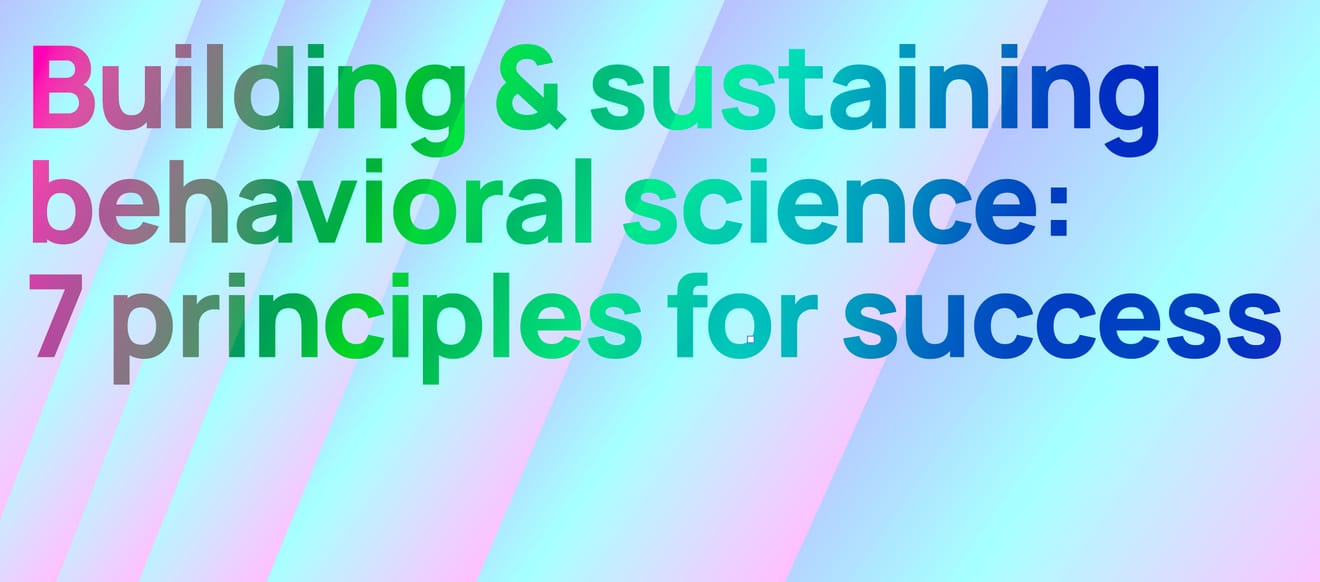What do behavioral scientists need to do to become valued partners to business leaders?
In this first article in our “BeSci Leaders” series, we’ll share seven key principles for success, drawn from leaders who have kept behavioral science visible and relevant over time within their organizations.
Behavioral science leaders often face an uphill battle in sustaining dedicated teams, budgets and resources within organizations. In addition to overcoming a host of familiar challenges, they must navigate continual changes in their environment. There are inevitable downturns in the business cycle, which often lead to budget cuts and/or layoffs. There are new organizational priorities, which compete for attention and resources. There are continual changes in management, which can involve the loss of senior executive sponsors.
However, there are success stories, in which Behavioral Science teams have persevered and prospered within large companies. With that optimistic thought in mind, I’d like to share seven principles for success, drawing upon my own experience and extended conversations with leaders of internal Behavioral Science teams, most notably Will Mailer of Commonwealth Bank of Australia (CBA) and Zarak Khan of Edward Jones.
1 - Start with Business Challenges (and Work Backwards)
When introducing Behavioral Science to the organization, always remember that business leaders are focused on their own opportunities, goals and challenges. So if they don’t quickly grasp how Behavioral Science can address their issues - or worse yet, if they view it as “something extra” that they need to learn - they will quickly lose interest.
Therefore, it’s important to learn which challenges are already “keeping leaders up at night” and show them how Behavioral Science can be part of the solution (via relevant case studies, ROI projections, etc.).
2 - Sell the Process (Not the Answer)
While it’s tempting to promote the field as providing quick, low-cost answers (i.e. nudges) to persistent problems, positioning a Behavioral Science team or function in this way is not responsible, effective nor sustainable. In addition, it plays into many managers’ limited perceptions of the field, which can lead them to be dismissive (i.e. “We already do Nudging.”).
So it’s important to quickly showcase a range of interventions and applications - such as behaviorally-informed incentive systems or work processes - which may challenge their incoming assumptions. It’s also valuable to convey that the field provides a process - (and/or a new set of tools or frameworks) that can often lead to unexpected solutions. This emphasis drives more reasonable expectations and creates the space for teams to contribute over time in systematic and repeating ways.
3 - Offer a Portfolio of Services
Of course, it’s tempting to insist that business leaders do Behavioral Science the “right way,” with the rigor that we’ve learned and applied in academia. But a “RCT or nothing” approach is unlikely to survive in a fast-paced and messy organisational context.
Instead, we need to offer our business partners flexible portfolios (or “product sets”) that calibrate with different timelines, opportunities and risk levels. These can range from 72-hour options (that provide directional input/insights) and quick/imperfect controlled tests to more scientific approaches, when the stakes are higher and budgets/timelines allow. The challenge is to clearly convey the trade-offs among these options - and ideally, to steer partners towards the right solution for their situation.
4 - Reduce the Barriers to Adoption
It’s also important for Behavioral Science leaders to focus on constantly bringing down the cost of adoption. Often, we find that the actual barriers to working with behavioral experts or teams are not financial, but rather procedural.
So it's important to deeply understand our partners' work processes and develop the right structures, skill-sets and triage processes, which make it easy for them to apply behavioral approaches (with a limited investment of their time and energy).
5 - Evolve & Adapt to Stay Relevant
The world is continually moving - and it’s critical to constantly review our tools, frameworks and methods to stay aligned with new trends, technologies and challenges. Most importantly, we need to stay attuned to changes in business priorities. For example, advances in AI and Machine Learning have drawn enormous investment - and focused leaders’ attention to new challenges, such as helping/persuading employees and customers to properly and fully utilize these emerging tools. This creates an enormous new opportunity for Behavioral Science, yet it can also divert resources away, if we aren’t seen as offering relevant tools.
6 - Educate & Enable Your Partners
As Behavioral Scientists, we’re understandably a bit protective of our field - and perhaps concerned that business people will act recklessly, if given the chance. However, it’s also vitally important to give our business partners a working sense of our tools and frameworks. This knowledge creates a sense of ownership, which fuels long-term advocacy. It also helps them proactively identify new behavioral opportunities, which will likely require our specialized expertise in some form.
7 - Document (& Share) the Success
Finally, it’s critical that we speak directly to our business partners’ KPIs, performance or financial metrics - and draw a direct line between our work and the bottom line. For example, our efforts typically address Type-1 or Type-2 errors, as they either help rectify a situation in which a desired behavior is not happening (Type 1) - or fix a scenario in which a harmful behavior is systematically happening (Type 2). Both are critical - and framing our work in this way neatly links it to delivering business value.
We should also remember that positive results are not only “wins” for Behavioral Science: They are “wins” for the business.
While it’s tempting to seek credit, a more sustainable approach is to abide by the maxim that success has many mothers and fathers. In fact, highlighting and celebrating business partners is exactly what will make them long-time advocates.
The Destination: A Valued Business Partner
As we view these seven principles collectively, it’s clear that they are all pointing in the same direction: They all support the larger objective of becoming a valued partner to business leaders.
Most importantly, this starts with meeting these business leaders on their own terms, by focusing on their objectives, using their language/metrics and/or adapting to their processes. Thus, the counterintuitive takeaway is that the best way to sustain behavioral science over time is by de-emphasizing the function or science itself - and instead positioning it as a means to address others’ challenges. In this way, successful BeSci leaders have nurtured many influential advocates within their organizations, who have helped them to navigate organizational changes, grow their impact and sustain long-term success.






